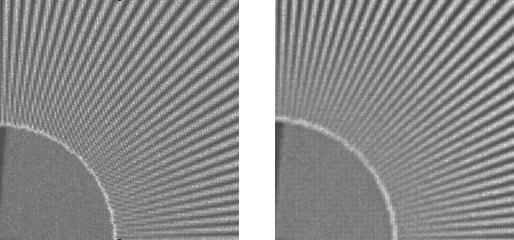Discover the advantage of detailed, artifact-free, full-function, 4x resolution-enhancement
A common technology in projection, pixel-shifting emulates a high-resolution image with multiple superimposed frames from a lower-resolution imager, giving you an overall lower system cost.
Christie Precision Pixel-Shifting (PPS) technology takes a unique approach to pixel-shifting for superior performance.
The basic concept of Christie® PPS technology is that four rapid half-pixel shifts of the image are superimposed to achieve either UHD resolution from 4 x HD resolution or UHD+ resolution from 4 x WUXGA resolution (illustration 1).

Illustration 1: Using Christie PPS technology, the half-pixel shifts of the image are superimposed, achieving UHD resolution (3840×2160) from 4 x HD resolution (1920×1080) or UHD+ resolution (3840×2400) from 4 x WUXGA resolution (1920×1200).
As you can see, Christie PPS technology faithfully maintains all the image content in that the full number of content pixels is presented. Developed by Christie engineers for the best possible pixel-shift performance, Christie PPS optimizes each aspect of the technology. Let’s take a closer look.
Accurate pixel motion
Christie PPS applies a custom pixel-shift actuator (an opto- mechanical glass assembly) that moves the image rapidly and accurately. The actuator motion is monitored by sensors and continuously updated by a controller that maintains positioning within 5% of exactly one half-pixel shift vertically and horizontally. This is true for every video rate, environmental condition, projector orientation, and over the full life of your projector.
It’s critical to the quality of a pixel-shifted image that the sub-image movement is fast and accurate. Christie PPS achieves this with our closed-loop motion control and the position accuracy is reported on the projector user interface (found under “Menu | Status | System”).
You can see the importance of this sub-image positioning when a Christie PPS projector is first turned on: in the first few seconds of operation the actuator is developing its positioning, and the image is visibly seen to sharpen as the correct positioning is achieved.

Signal Festival 2023. Thermal Drift. Artist: Rafael Lozano-Hemmer Technology: Christie M 4K25 RGB pure laser projector.
Precision glass specification
The actuator that’s used to move the image between its four sub-images is an optical component where the glass specification, particularly the flatness of its faces, has a direct impact on image quality. In developing our actuator, Christie® went through a phase of tightening up the glass specification to preserve the excellent MTF-performance of our projection lenses. Our actuators now have precision glass specifications that result in a notably sharper image through the actuator glass.
Flicker-free imaging
Christie PPS cycles through the four projected sub-images exceptionally fast. Christie developed this approach to avoid the image flicker that can occur when the content has repeating fine detail at worst-case spacing. In this scenario, the sub-image sampling can result in perceptible shimmer or flicker. By cycling between the sub-images at a very high rate, Christie PPS moves any sub-sample patterns to a rate above our ability to perceive flicker.
Image processing
Pixel-shifting projectors typically apply digital image sharpening to compensate for the “softening” that results from superimposing images with pixels larger than the content pixels. Many competing pixel-shift implementations apply too aggressive sharpening, in part to compensate for other parts of their implementations that are less than optimal. The result of this aggressive sharpening is regular details in the content can have false low-frequency patterns added, and slow-moving sharp lines in video can have strong flicker.
Christie PPS only adds sharpening that is calculated to compensate for the too-large imager pixels. As a result, both static and video images are artifact-free with Christie PPS.
Full functionality
Christie PPS supports operating the projector at all video rates up to 120 Hz, including 3D across the full range of glasses dark times, without loss of brightness versus non-PPS modes. This capability is a result of our active control of actuator position, and it means you can use Christie projectors with our PPS technology in virtually any application without having to make any compromises.
Full-detail imagery, no artifacts

Illustration 2: Native-imager projector (left) and Christie PPS (right) test images. Christie PPS shows a slight softening, but has full detail and no added artifacts.
Pixel-shifting is a viable solution in many projection applications where a native-imager solution is not available or too expensive. Fundamentally, pixel-shifting results in a slightly softer image because larger native pixels are superimposed. Above are sample photographs (illustration 2) of native UHD (left) and Christie PPS UHD (right) test images. The Christie PPS test image shows a slight softening, but full detail is there, with no added artifacts. By optimizing all other aspects of our implementation, Christie PPS technology achieves results that are superior to other pixel-shifting projectors and very close to what a native imager projector achieves.
Christie Precision Pixel-Shifting technology was developed exclusively for Christie M 4K RGB Series projectors. Find out more about the M 4K RGB Series.









